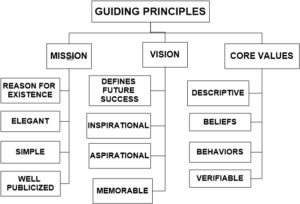
As noted in the previous post, Key Performance Indicators – Part II: Definition, the theme of this post was going to be A University Should Be Managed as If It Were a Business. In all of my previous roles, as a university administrator or the creator of this blog, I made no efforts to hide my sentiments concerning this proposition. It was always one of my operating premises.

In 2016, I started a series of posts on the theme The Business Model of All Higher Education Is Broken. Even in the title of the series, I attempted to make the point that institutions of higher education (IHEs) must view themselves as business enterprises. As an academician, I believe that institutions of higher education must be more than businesses. However, if they don’t operate using the best business and management techniques then they will surely fail, which is what we have seen with 2,000 American IHEs since 1950.

Milton Greenberg in his seminal essay “The University Is Not a Business (and Other Fantasies)” published in EDUCAUSE Review, vol. 39, no. 2 (March/April 2004), argues forcefully that a university should be managed as if it were a business.
Very early in his essay, Greenberg proclaims, “ Presumably, a “business” involves the hierarchical and orderly management of people, property, productivity, and finance for profit.” The primary counterarguments of academicians to Greenberg’s position hinge on three concepts he introduces in this sentence: hierarchical management, productivity, and profit. In three future posts in this series, I will separately tackle each of these counterarguments.

But first I return to present my argument on why universities should be run more like businesses. In studying the 2,000 deceased IHEs, Ron Burwell and I noticed eight factors that we believe contributed negatively to their vitality and their eventual morbidity. The eight factors are shown in the diagram to the left.
Although the eight factors are obviously not completely independent of each other, they are sufficiently different to warrant separate consideration. Additionally, that consideration would take up too much space for one blog post. Thus, I will address each of the factors in upcoming posts.

To give you a taste of how I will be introducing and treating these factors, I present a Mind Map Diagram on the right illustrating the three components which define the Guiding Principles Factor.
Under each of the three components, the diagram presents the major ingredients that go into measuring the success of the organization in that component.

In order to simplify our study, without losing the crux of discovering the reasons why institutions failed, we have chosen to use the straight-forward three-point scale of Thriving, Surviving, and Dying. Instead of attempting to construct complicated, quantitative scales to measure each subfactor of our eight factors, we are going to use a subjective approach similar to Supreme Court Justice Potter Stewart’s take on defining pornography: “I may not be able to define it. But I know it when I see it.”

With each component in our factors, most reasonable observers can easily determine whether: 1) an organization is extremely successful and thriving in terms of this component, 2) just barely getting by or only surviving, or 3) failing badly and falling far short of success or flat out dying. This approach permits us to use a simple gauge to illustrate the vitality/morbidity level of an institution.
We will also associate a three-point numerical scale with our three categories: Thriving (+1); Surviving (0); Dying (-1). We then added the scores across all eight factors. Repeating this process for each institution in our database of closed colleges and universities, we were not at all surprised to find that the total score of each closed institution was negative. No closed college had a total positive score. Some individual factor scores were positive but they were outweighed by a much larger share of factors with negative scores.
If this model is to have predictive capabilities it must also work with all types of institutions. We have tried our model out on a number of institutions that we identified as thriving, surviving, and outright struggling.

In this process, we did find a number of colleges that were still operating which had negative VMIs. In each of these cases, the colleges involved could easily be classified as struggling or just barely surviving. They were definitely not thriving.
Although I believe that it is difficult to “kill a college” it is not impossible. Just ask the constituencies of Newbury College (MA), College of New Rochelle (NY), Green Mountain College (VT), and Hampshire College (VT).
For institutions that we identified as thriving, just as we expected each of them had a total VMI that was positive. What about the struggling institutions with positive VMIs? We believe that these institutions must address the factors that are negative or “zero” or they could be heading for more serious trouble.
In the post above I outline several different directions that I could go with my next post. At this point, I am working on a post that delves more deeply into the VMI Factor Guiding Principles which I introduced in this post. Watch for it next Tuesday, March 12, 2019.
Leave a Reply